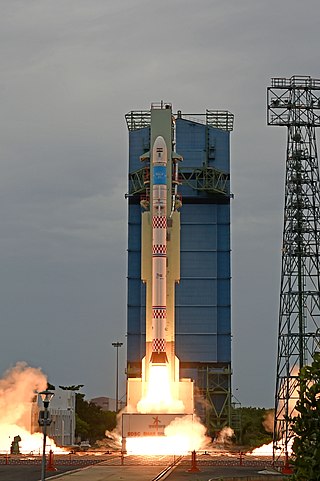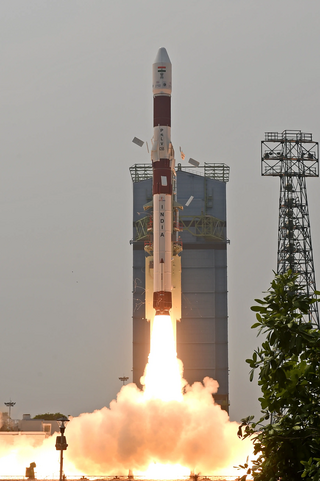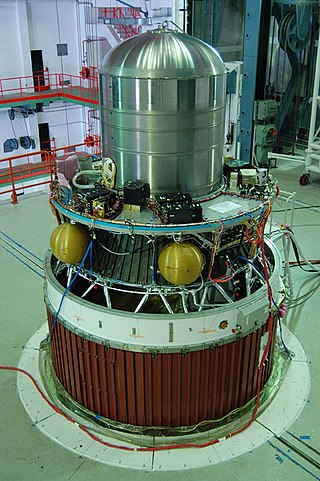
The Polar Satellite Launch Vehicle (PSLV) is an expendable medium-lift launch vehicle designed and operated by the Indian Space Research Organisation (ISRO). It was developed to allow India to launch its Indian Remote Sensing (IRS) satellites into Sun-synchronous orbits, a service that was, until the advent of the PSLV in 1993, only commercially available from Russia. PSLV can also launch small size satellites into Geostationary Transfer Orbit (GTO).

The Indian Space Research Organisation is the national space agency of India. It operates as the primary research and development arm of the Department of Space (DoS), which is directly overseen by the Prime Minister of India while the Chairman of ISRO also acts as the executive of DoS. ISRO is primarily responsible for performing tasks related to space-based operations, space exploration, international space cooperation and the development of related technologies. ISRO is one of the six government space agencies in the world that possesses full launch capabilities, can deploy cryogenic engines, can launch extraterrestrial missions and operate a large fleet of artificial satellites. ISRO is one of the four government space agencies to have soft landing (unmanned) capabilities.

The Launch Vehicle Mark-3 or LVM3 is a three-stage medium-lift launch vehicle developed by the Indian Space Research Organisation (ISRO). Primarily designed to launch communication satellites into geostationary orbit, it is also due to launch crewed missions under the Indian Human Spaceflight Programme. LVM3 has a higher payload capacity than its predecessor, GSLV.

Reusable Launch Vehicle–Technology Demonstration Programme is a series of technology demonstration missions that has been conceived by the Indian Space Research Organisation (ISRO) as a first step towards realising a Two Stage To Orbit (TSTO) re-usable launch vehicle, in which the second stage is a spaceplane.

Dhruva Space Private Limited is an Indian private aerospace manufacturer headquartered in Hyderabad, Telangana. Founded in 2012 by Sanjay Srikanth Nekkanti, the company is engaged in the development of small satellites in the commercial, governmental and academic markets. It provides full-stack space-engineering solutions across launch, space and ground segments – namely, the building, launching and operation of satellites.
PSLV-C34 was the 36th mission of the PSLV program and 14th mission of PSLV in XL configuration. The PSLV-C34 successfully carried and deployed 20 satellites in the Sun-synchronous orbit. With a launch mass of 320,000 kilograms (710,000 lb) and payload mass of 1,288 kilograms (2,840 lb), the C34 set a new record of deploying the maximum number of satellites by Indian Space Research Organisation in a single mission. The PSLV-C34 carried One Cartosat-2 satellite, SathyabamaSat, Swayam & 17 other satellites from United States, Canada, Germany & Indonesia.

IRNSS-1H was the eighth in the Indian Regional Navigational Satellite System (IRNSS) series of satellites, after IRNSS-1A, IRNSS-1B, IRNSS-1C, IRNSS-1D, IRNSS-1E, IRNSS-1F and IRNSS-1G. It was lost in the launch failure of PSLV-C39 on August 31, 2017.

The Small Satellite Launch Vehicle (SSLV) is a small-lift launch vehicle developed by ISRO with payload capacity to deliver 500 kg (1,100 lb) to low Earth orbit or 300 kg (660 lb) to Sun-synchronous orbit for launching small satellites, with the capability to support multiple orbital drop-offs. SSLV is made keeping low cost, low turnaround time in mind with launch-on-demand flexibility under minimal infrastructure requirements.

The X-ray Polarimeter Satellite (XPoSat) is an Indian Space Research Organisation (ISRO) manufactured space observatory to study polarisation of cosmic X-rays. It was launched on 1 January 2024 on a PSLV rocket, and it has an expected operational lifespan of at least five years.

AgniKul Cosmos Private Limited is an Indian aerospace manufacturer based in National Center for Combustion R&D (NCRD) of IIT Madras, Chennai. The start up aims to develop and launch its own small-lift launch vehicle such as the Agnibaan, capable of placing 100 kg (220 lb) payload into a 700 km (430 mi) orbit. The first commercial launch was expected in 2022. However, no launch happened in that year. The first suborbital mission will be conducted on 22 March 2024.

The PSLV-C53 is the 55th mission of the Polar Satellite Launch Vehicle (PSLV) and 15th mission using PSLV-Core Alone variant. PSLV-C53 is the second dedicated commercial mission of NSIL.
Kulasekarapattinam Spaceport is the second spaceport of the Indian Space Research Organisation (ISRO), located in Kulasekarapattinam, a coastal village in Thoothukudi district of Tamil Nadu, India. The facility is being constructed over 2,350 acres. As of September 2023, more than 90% of land has been acquired and the groundbreaking was done on 28 February 2024.
Chandrayaan-4 is a planned lunar sample-return mission and the fourth mission in the Chandrayaan programme, a series of lunar-exploration missions developed by the Indian Space Research Organisation (ISRO). The mission is currently under conceptualisation phase and is slated for launch no earlier than 2028.

The Indian Orbital Space Station, officially called, Bharatiya Antariksha Station, is a planned modular space station to be constructed by India and operated by the Indian Space Research Organisation (ISRO). The space station would weigh 20 tonnes and maintain an orbit of approximately 400 kilometres above the Earth, where astronauts could stay for 15–20 days. Originally planned to be completed by 2030, it was later postponed to 2035 due to delays caused by technical issues related with the Gaganyaan crewed spaceflight mission and the COVID-19 pandemic in India. As of December 2023, the first module is expected to be launched in 2028 on an LVM3 launch vehicle, with the remaining modules to be launched by 2035 on the Next Generation Launch Vehicle.

The PSLV-C55 was the 57th mission of Indian Space Research Organisation's Polar Satellite Launch Vehicle (PSLV) and the 16th flight of the PSLV-CA variant.
The Next Generation Launch Vehicle or NGLV is a three-stage partially reusable rocket, currently under development by the Indian Space Research Organisation (ISRO). This vehicle is designed to replace currently operational systems like PSLV, GSLV and LVM3.

PSLV Orbital Experiment Platform (POEM) also known as PSLV Stage 4 Orbital Platform (PS4-OP) is an orbital micro-gravity test bed based on spent fourth stage of PSLV. By adding modular subsystems for power generation, communication and stabilization like photovoltaic cells, Telemetry and Telecommand (TT&C) package, attitude control system, data storage etc to the PSLV fourth stage, it can function as a satellite bus. This augmented stage can then host payloads for up to six months while in orbit, making it useful for qualifying components, gaining space heritage and conduct experiments in micro-gravity conditions. Usually the fourth stage of PSLV is discarded after deployment of satellite and remains in orbit for a significant duration in a passive state as a piece of space debris.














